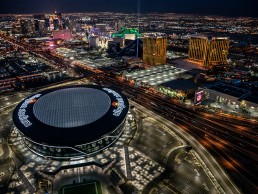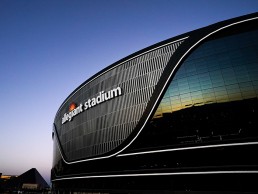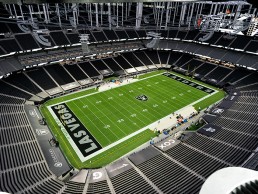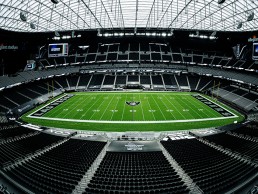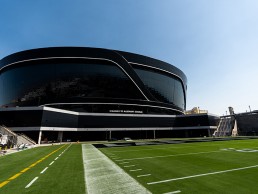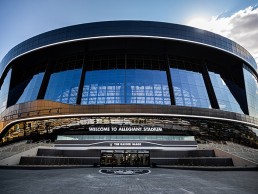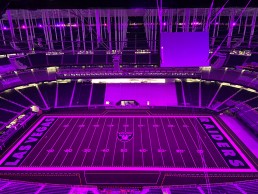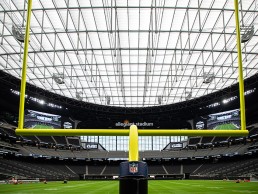This website uses cookies so that we can provide you with the best user experience possible. Cookie information is stored in your browser and performs functions such as recognising you when you return to our website and helping our team to understand which sections of the website you find most interesting and useful.
Allegiant Stadium
ProjectAllegiant StadiumLocationLas Vegas, USAManufacturers Samsung, Ephesus Lighting, JBL Professional, Ross Video, Camatic, Sony, Evertz, Canon, ChyronHego, JMA WirelessArchitectMANICA, HNTBInstallerArchkey TechnologiesSubmitted by Allegiant Stadium
It’s been a long time coming, but the Raiders have found their permanent home in Las Vegas with the opening of the incredible Allegiant Stadium. The $2 billion venue, located adjacent to the world-famous Las Vegas strip, is a truly multipurpose stadium and global events destination, delivering for both the franchise and the city.
Allegiant Stadium, which has a total capacity of 65,000 – expandable to 72,000 for Super Bowl events – is one of the most technologically advanced, which, combined with a truly striking design, already puts it on the map when it comes to must-visit venues.
The design for Allegiant Stadium came from a partnership between MANICA and HNTB, with both firms coming together to create a sleek, modern venue that was not just the new home for the Raiders, but perfectly suited to its surroundings in Las Vegas.
As the Allegiant Stadium design began to take shape, JMA Wireless were enlisted to assist with the design for the wireless system throughout the venue. As a leading global innovator, JMA connects the mobile world with high quality solutions that ensure reliability, streamline operations, provide unrivalled cost savings, and maximise wireless performance.
The broadcast setup is a vital part of the infrastructure at Allegiant Stadium, with Wrightson, Johnson, Hadden & Williams (WJHW) enlisted as a consultant for the production control room design. Justin Lange, Manager of Audio, Video, Broadcast and Cisco Vision Operations at Allegiant Stadium, explained further: “Our production control centres around a full 2110 IP Evertz EXE video and audio router. The building is outfitted with a 5ME Ross Acuity production switcher with two, four bus panels. Three Ross Xpression nodes power six key/fill outputs for production graphics, while EVS drives twenty channels of record and eight channels of playback. ChyronHego provided their Virtual 1st Down solution, as well as their tele-strator product called Paint that enhances the graphical capabilities of the facility.
The broadcast setup is a vital part of the infrastructure at Allegiant Stadium, with Wrightson, Johnson, Hadden & Williams (WJHW) enlisted as a consultant for the production control room design. Justin Lange, Manager of Audio, Video, Broadcast and Cisco Vision Operations at Allegiant Stadium, added more insight into the technology.
“Our production control centres around a full 2110 IP Evertz EXE video and audio router. The building is outfitted with a 5ME Ross Acuity production switcher with two, four bus panels. Three Ross Xpression nodes power six key/fill outputs for production graphics, while EVS drives twenty channels of record and eight channels of playback. ChyronHego provided their Virtual 1st Down solution, as well as their tele-strator product called Paint that enhances the graphical capabilities of the facility.
“Production control is rounded out by the use of seven Sony HDR cameras, with a mixture of 4300, 3500 and 3100 models. Lenses are all Canon manufactured with three 90x, two 60x, two 24x and one wide angle model.”
“Production control is rounded out by the use of seven Sony HDR cameras, with a mixture of 4300, 3500 and 3100 models. Lenses are all Canon manufactured with three 90x, two 60x, two 24x and one wide angle model.”
With future proofing at the forefront of the project, Samsung’s LED display products are used exclusively throughout the venue, including the videoboards, score clocks and multiple ribbon displays within the seating bowls.
“There are a total of 41 video screens throughout the venue, totalling 67,000 sq. ft. Beyond the LED displays, there are an additional 2,553 displays throughout the stadium, ranging in size from 27” to 98”. Samsung also had the honour of outfitting the Intermountain Health Performance Center in Henderson, NV. The training facility’s theatre room is home to the first 1.2mm, 4K high-definition resolution (HDR) screen in the NFL measuring 9ft. x 16ft.,” added Brett Unzicker, Vice President, LEE-S, Display Division, Samsung Electronics America.
Ephesus Lighting fixtures were the first LED lighting solution to illuminate an NFL stadium and, having installed LED sports lighting solutions at many of the most iconic NFL stadiums, the team at Allegiant Stadium reached out to Ephesus.
Justin explained further: “The sport lighting system is driven by Ephesus Stadium Pro fixtures, while the seat lighting is taken care of by the Ephesus All Field fixtures.
“There are also 80 colour-changing Ephesus RGBA fixtures included in the main bowl lighting system. The bowl and back of house lighting system is all controlled under ETC Paradigm, making concert blackouts and other full stadium preset changes quick and easy.”
Michael Quijano, Director of Business Development & Product Marketing at Ephesus Lighting, continued: “Our Stadium Pro fixture provides the bulk of the lighting, but, once it was decided to set a new standard in entertainment functionality, we added 80 of our Prism RGBA fixtures – an unprecedented number of colour fixtures. The fixtures were delivered to the venue pre-racked and pre-aimed so expedite the installation process.”
A state-of-the-art sound system is something that had to be included at Allegiant Stadium to further enhance the experience – and it was JBL Professional’s revolutionary audio technology and sound intelligibility that made it the ideal choice for the venue.
Justin discussed the JBL system used at the stadium: “The bowl audio is a JBL VLA601H line array system consisting of 14, 10-box arrays, with six middle arrays also containing a field fill box on each.
“Each array contains six PD5125 subs hung directly behind the main array to evenly distribute the lows throughout the building and help with timing. A Yamaha CL5 drives the house system in conjunction with two 3224 Rios and RSIOs for digital transport around the stadium.
“The rest of the concourse and back of house system is also JBL, with control coming via Audio Architect on the DSP side, and Crestron doing the public facing control of clubs and suites.”
